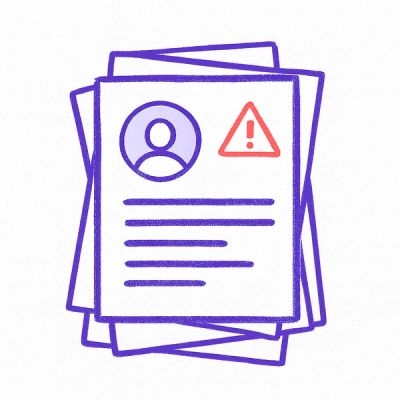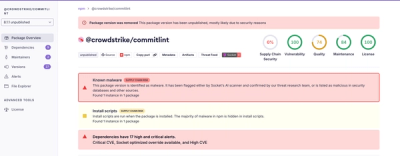
Research
Malicious fezbox npm Package Steals Browser Passwords from Cookies via Innovative QR Code Steganographic Technique
A malicious package uses a QR code as steganography in an innovative technique.
Human Preference Score v2: A Solid Benchmark for Evaluating Human Preferences of Text-to-Image Synthesis.

This is the official repository for the paper: Human Preference Score v2: A Solid Benchmark for Evaluating Human Preferences of Text-to-Image Synthesis.
SDXL Refiner 0.9 model in the benchmark.SDXL Base 0.9 model in the benchmark.
Human Preference Dataset v2 (HPD v2): a large-scale (798k preference choices / 430k images), a well-annotated dataset of human preference choices on images generated by text-to-image generative models.
Human Preference Score v2 (HPS v2): a preference prediction model trained on HPD v2. HPS v2 can be used to compare images generated with the same prompt. We also provide a fair, stable, and easy-to-use set of evaluation prompts for text-to-image generative models.
The HPS benchmark evaluates models' capability of generating images of 4 styles: Animation, Concept-art, Painting, and Photo.
| Model | Animation | Concept-art | Painting | Photo | Averaged |
|---|---|---|---|---|---|
| Dreamlike Photoreal 2.0 | 28.24 | 27.60 | 27.59 | 27.99 | 27.86 |
| SDXL Refiner 0.9 | 28.45 | 27.66 | 27.67 | 27.46 | 27.80 |
| Realistic Vision | 28.22 | 27.53 | 27.56 | 27.75 | 27.77 |
| SDXL Base 0.9 | 28.42 | 27.63 | 27.60 | 27.29 | 27.73 |
| Deliberate | 28.13 | 27.46 | 27.45 | 27.62 | 27.67 |
| ChilloutMix | 27.92 | 27.29 | 27.32 | 27.61 | 27.54 |
| MajicMix Realistic | 27.88 | 27.19 | 27.22 | 27.64 | 27.48 |
| Openjourney | 27.85 | 27.18 | 27.25 | 27.53 | 27.45 |
| DeepFloyd-XL | 27.64 | 26.83 | 26.86 | 27.75 | 27.27 |
| Epic Diffusion | 27.57 | 26.96 | 27.03 | 27.49 | 27.26 |
| Stable Diffusion v2.0 | 27.48 | 26.89 | 26.86 | 27.46 | 27.17 |
| Stable Diffusion v1.4 | 27.26 | 26.61 | 26.66 | 27.27 | 26.95 |
| DALL·E 2 | 27.34 | 26.54 | 26.68 | 27.24 | 26.95 |
| Versatile Diffusion | 26.59 | 26.28 | 26.43 | 27.05 | 26.59 |
| CogView2 | 26.50 | 26.59 | 26.33 | 26.44 | 26.47 |
| VQGAN + CLIP | 26.44 | 26.53 | 26.47 | 26.12 | 26.39 |
| DALL·E mini | 26.10 | 25.56 | 25.56 | 26.12 | 25.83 |
| Latent Diffusion | 25.73 | 25.15 | 25.25 | 26.97 | 25.78 |
| FuseDream | 25.26 | 25.15 | 25.13 | 25.57 | 25.28 |
| VQ-Diffusion | 24.97 | 24.70 | 25.01 | 25.71 | 25.10 |
| LAFITE | 24.63 | 24.38 | 24.43 | 25.81 | 24.81 |
| GLIDE | 23.34 | 23.08 | 23.27 | 24.50 | 23.55 |
| Model | Animation | Concept-art | Painting | Photo | Averaged |
|---|---|---|---|---|---|
| SDXL Refiner 0.9 | 33.26 | 32.07 | 31.63 | 28.38 | 31.34 |
| SDXL Base 0.9 | 32.84 | 31.36 | 30.86 | 27.48 | 30.63 |
| Deliberate | 31.46 | 30.48 | 30.17 | 28.83 | 30.23 |
| Realistic Vision | 31.01 | 29.95 | 30.00 | 28.61 | 29.89 |
| Dreamlike Photoreal 2.0 | 30.87 | 29.75 | 29.46 | 28.85 | 29.73 |
| MajicMix Realistic | 29.67 | 28.50 | 28.44 | 28.02 | 28.66 |
| ChilloutMix | 29.46 | 28.46 | 28.35 | 27.63 | 28.47 |
| Openjourney | 28.37 | 27.38 | 27.53 | 26.66 | 27.48 |
| DeepFloyd-XL | 27.71 | 26.07 | 25.79 | 27.96 | 26.88 |
| Epic Diffusion | 27.07 | 26.14 | 26.17 | 26.43 | 26.45 |
| Stable Diffusion v2.0 | 27.09 | 26.02 | 25.68 | 26.73 | 26.38 |
| Stable Diffusion v1.4 | 26.03 | 24.87 | 24.80 | 25.70 | 25.35 |
| DALL·E 2 | 26.38 | 24.51 | 24.93 | 25.55 | 25.34 |
| Versatile Diffusion | 23.69 | 23.39 | 24.02 | 24.64 | 23.93 |
| CogView2 | 23.64 | 24.86 | 23.40 | 22.68 | 23.64 |
| VQGAN + CLIP | 22.55 | 23.76 | 23.41 | 21.51 | 22.81 |
| DALL·E mini | 21.54 | 20.50 | 20.32 | 21.72 | 21.02 |
| Latent Diffusion | 20.63 | 19.65 | 19.79 | 21.26 | 20.34 |
| FuseDream | 19.16 | 19.37 | 19.07 | 20.07 | 19.42 |
| VQ-Diffusion | 18.44 | 18.31 | 19.24 | 20.62 | 19.15 |
| LAFITE | 17.79 | 17.55 | 17.61 | 20.88 | 18.46 |
| GLIDE | 13.90 | 13.50 | 13.94 | 16.72 | 14.51 |
# Method 1: Pypi download and install
pip install hpsv2
# Method 2: install locally
git clone https://github.com/tgxs002/HPSv2.git
cd HPSv2
pip install -e .
# Optional: images for reproducing our benchmark will be downloaded here
# default: ~/.cache/hpsv2/
export HPS_ROOT=/your/cache/path
After installation, we show how to:
We also provide command line interfaces for debugging purposes.
You can score and compare several images generated by the same prompt by running the following code:
import hpsv2
# imgs_path can be a list of image paths, with the images generated by the same prompt
# or image path of string type
# or image of PIL.Image.Image type
result = hpsv2.score(imgs_path, '<prompt>', hps_version="v2.1")
Note: Comparison is only meaningful for images generated by the same prompt. You can also pass "v2.0" to hps_version to use our updated model. Scores can not be directly compared between v2.0 and v2.1.
We also provide images generated by models in our benchmark used for evaluation. You can easily download the data and evaluate the models by running the following code.
import hpsv2
print(hpsv2.get_available_models()) # Get models that have access to data
hpsv2.evaluate_benchmark('<model_name>')
To evaluate your own text-to-image generative model, you can prepare the images for evaluation base on the benchmark prompts we provide by running the following code:
import os
import hpsv2
# Get benchmark prompts (<style> = all, anime, concept-art, paintings, photo)
all_prompts = hpsv2.benchmark_prompts('all')
# Iterate over the benchmark prompts to generate images
for style, prompts in all_prompts.items():
for idx, prompt in enumerate(prompts):
image = TextToImageModel(prompt)
# TextToImageModel is the model you want to evaluate
image.save(os.path.join("<image_path>", style, f"{idx:05d}.jpg"))
# <image_path> is the folder path to store generated images, as the input of hpsv2.evaluate().
And then run the following code to conduct evaluation:
import hpsv2
# <image_path> is the same as <image_path> in the prevoius part.
# <hps_version> is the version of HPS model, it can be v2 or v2.1. Default to v2.
hpsv2.evaluate("<images_path>", hps_version="<hps_version>")
Evaluating HPS v2's correlation with human preference choices:
| Model | Acc. on ImageReward test set (%) | Acc. on HPD v2 test set (%) | Acc. on new test set (%) |
|---|---|---|---|
| Aesthetic Score Predictor | 57.4 | 76.8 | 57.8* |
| ImageReward | 65.1 | 74.0 | 67.4* |
| HPS | 61.2 | 77.6 | 66.8* |
| PickScore | 62.9 | 79.8 | 67.8* |
| Single Human | 65.3 | 78.1 | 65.4* |
| HPS v2 | 65.7 | 83.3 | 73.2* |
| HPS v2.1 | 66.8 | 84.1 | 74.8* |
* The new test set is another test set annotated similarly to the HPD v2 test set, except that images are generated from 10 better models (Dreamlike Photoreal 2.0, SDXL Refiner 0.9, Realistic Vision, SDXL Base 0.9, Deliberate, ChilloutMix, MajicMix Realistic, Openjourney, DeepFloyd-XL, Epic Diffusion).
HPS v2 checkpoint can be downloaded from here. The model and live demo is also hosted on 🤗 Hugging Face at here.
Run the following commands to evaluate the HPS v2 model on HPD v2 test set and ImageReward test set (Need to install the package hpsv2 first):
# evaluate on HPD v2 test set
python evaluation.py --data-type test --data-path /path/to/HPD --image-path /path/to/image_folder
# evaluate on ImageReward test set
python evaluation.py --data-type ImageReward --data-path /path/to/IR --image-path /path/to/image_folder
The prompts in our dataset are sourced from DiffusionDB and MSCOCO Captions. Prompts from DiffusionDB are first cleaned by ChatGPT to remove biased function words. Human annotators are tasked to rank images generated by different text-to-image generative models from the same prompt. Totally there are about 798k pairwise comparisons of images for over 430k images and 107k prompts, 645k pairs for training split and 153k pairs for test split.
Image sources of HPD v2:
| Source | # of images |
|---|---|
| CogView2 | 73697 |
| DALL·E 2 | 101869 |
| GLIDE (mini) | 400 |
| Stable Diffusion v1.4 | 101869 |
| Stable Diffusion v2.0 | 101869 |
| LAFITE | 400 |
| VQ-GAN+CLIP | 400 |
| VQ-Diffusion | 400 |
| FuseDream | 400 |
| COCO Captions | 28272 |
Currently, the test data can be downloaded from here. You can inspect the test data at https://tgxs002.github.io/hpd_test_vis/. Here is a screenshot:

The training dataset will be released soon. Once unzipped, you should get a folder with the following structure:
HPD
---- train/
-------- {image_id}.jpg
---- test/
-------- {image_id}.jpg
---- train.json
---- test.json
---- benchmark/
-------- benchmark_imgs/
------------ {model_id}/
---------------- {image_id}.jpg
-------- drawbench/
------------ {model_id}/
---------------- {image_id}.jpg
-------- anime.json
-------- concept-art.json
-------- paintings.json
-------- photo.json
-------- drawbench.json
The annotation file, train.json, is organized as:
[
{
'human_preference': list[int], # 1 for preference
'prompt': str,
'file_path': list[str],
'user_hash': str,
},
...
]
The annotation file, test.json, is organized as:
[
{
'prompt': str,
'image_path': list[str],
'rank': list[int], # averaged ranking result for image at the same index in image_path,
'raw_annotations': list[{'rank', 'user_hash'}] # raw ranking result from each annotator
},
...
]
The benchmark prompts file, ie. anime.json is pure prompts. The corresponding image can be found in the folder of the corresponding model by indexing the prompt.
The generated images in our experiments can be downloaded from here.
The following script reproduces the benchmark table and our results on DrawBench (reported in the paper) (Need to install the package hpsv2 first):
# HPS v2 benchmark (for more than one models)
python evaluation.py --data-type benchmark_all --data-path /path/to/HPD/benchmark --image-path /path/to/benchmark_imgs
# HPS v2 benchmark (for only one models)
python evaluation.py --data-type benchmark --data-path /path/to/HPD/benchmark --image-path /path/to/benchmark_imgs/${model_name}
# DrawBench
python evaluation.py --data-type drawbench --data-path /path/to/HPD/benchmark --image-path /path/to/drawbench_imgs
We provide one example image in the asset/images directory of this repo. The corresponding prompt is "A cat with two horns on its head".
Run the following commands to score the single generated image and the corresponding prompt (Need to install the package hpsv2 first):
python img_score.py --image-path assets/demo_image.jpg --prompt 'A cat with two horns on its head'
where the parameter image-path can accept multiple values.
To train your own human preference predictor, just change the corresponding path in configs/controller.sh and run the following command:
# if you are running locally
bash configs/HPSv2.sh train 8 local
# if you are running on slurm
bash configs/HPSv2.sh train 8 ${quota_type}
@article{wu2023human,
title={Human Preference Score v2: A Solid Benchmark for Evaluating Human Preferences of Text-to-Image Synthesis},
author={Wu, Xiaoshi and Hao, Yiming and Sun, Keqiang and Chen, Yixiong and Zhu, Feng and Zhao, Rui and Li, Hongsheng},
journal={arXiv preprint arXiv:2306.09341},
year={2023}
}
FAQs
Human Preference Score v2: A Solid Benchmark for Evaluating Human Preferences of Text-to-Image Synthesis.
We found that hpsv2 demonstrated a healthy version release cadence and project activity because the last version was released less than a year ago. It has 1 open source maintainer collaborating on the project.
Did you know?

Socket for GitHub automatically highlights issues in each pull request and monitors the health of all your open source dependencies. Discover the contents of your packages and block harmful activity before you install or update your dependencies.

Research
A malicious package uses a QR code as steganography in an innovative technique.

Research
/Security News
Socket identified 80 fake candidates targeting engineering roles, including suspected North Korean operators, exposing the new reality of hiring as a security function.

Application Security
/Research
/Security News
Socket detected multiple compromised CrowdStrike npm packages, continuing the "Shai-Hulud" supply chain attack that has now impacted nearly 500 packages.